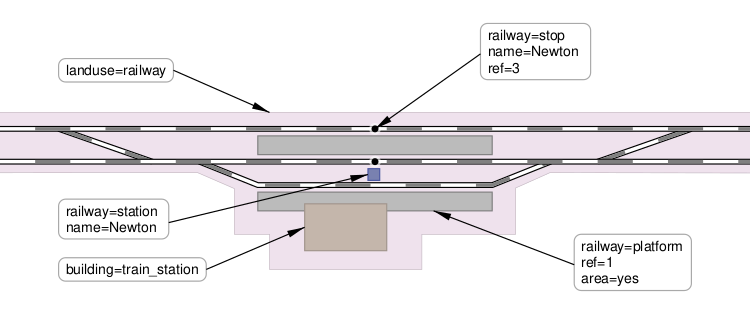Tag:railway=station
| Description |
|---|
| A railway station. |
| Rendering in OSM Carto |
| Rendering in OSM Carto |

|
| Group: railways |
| Used on these elements |
| Useful combination |
|
| See also |
| Status: de facto |
| Tools for this tag |
|
- Main article: Railway stations
Railway stations (including main line, light rail, subway, etc.) are places where goods or passengers are loaded and unloaded. railway=station should be tagged as either an polygon area covering the whole station (tracks, buildings, platforms, etc.), or as a node, placed at the practical centre of the station (i.e. near platforms).
How to map
Element types
As an area
![]() The area of a station begins at the entry signal at one side and ends at the entry signals at the other side. It must represent the station grounds, not only the station building (which, if it exists, should be tagged with building=train_station).
The area of a station begins at the entry signal at one side and ends at the entry signals at the other side. It must represent the station grounds, not only the station building (which, if it exists, should be tagged with building=train_station).
As a node
![]() If mapped as a node it is usually an unconnected node in the middle of the station (within the platform area). It should not be part of a railway=rail way. There should be only one railway=station element for each station (see One feature, one OSM element).
If mapped as a node it is usually an unconnected node in the middle of the station (within the platform area). It should not be part of a railway=rail way. There should be only one railway=station element for each station (see One feature, one OSM element). 
Tags
| Key | Value | Description |
|---|---|---|
| railway | station | |
| name | <station name> | The name of the station. For preference use the name on the signs at the station. |
| landuse | railway | When railway=station is mapped as a node this tag can be added to a closed polygon mapped to indicate the extents of the land owned & used by the operator as a station. |
| railway:ref | <station code> | The code used for the station. In North America, this might be something like NYP for New York Penn Station or OSB for Old Saybrook Station if it's an Amtrak station. In Germany, the Ril 100 code would be something like KN for Neuss Hbf. Abbreviations used by companies other than the operator can be tagged using railway:ref:(company)=*.
|
| operator | <operator_name> | The station's operator. |
| network | <network_name(s)> | The name of the network the station belongs to. There maybe multiple values. |
| wikipedia | <lang>:<article name> | The Wikipedia article relating to the actual station (Not the railway's operator or network). For formatting the tag, refer to the wikipedia page. |
| start_date | <date> | The date the station was put into service. For formatting the tag, refer to the start_date=* page. |
| uic_ref | <number> | UIC's (International Union of Railways) assigned reference number for the station. |
| uic_name | <name> | UIC's (International Union of Railways) assigned name for the station. |
Station types
Where a mainline station and metro station (or other railway like station) share the same station building, consider if they should be modelled as separate stations or as a single station. The associated Wikipedia articles of the facilities might assist with the decision. If the facilities are run by separate organisations[1] (for example a heritage station next to a mainline station) then it is probably better to map them using two separate railway=station tags.
For freight stations, add railway:traffic_mode=freight. Data consumers should consider that not all railway stations are passenger-only.
Distinction between halt and station
The distinction between railway=halt and railway=station might differ from country to country. A halt is occasionally distinguished by its smaller size compared to a station, although it's unclear what size defines the difference. It can also be classified as a request stop. To make it explicitly clear, tag a request stop station as request_stop=yes.
- In Britain, after a discussion, railway=halt has been removed. All are now railway=station. It was felt the definition of halt was too ambiguous & subjective for OSM. Additional, objective, sub-tags are being added to stations such as request_stop=*, usage=*, platforms=* etc.
- In Belgium, railway=station is only for staffed stations. NMBS/SNCB stations without any station building or stations where ticket offices are permanently closed are tagged as railway=halt.
- In Denmark, Hungary, Italy and German-speaking countries, stations without points ("switches") where only passenger trains stop are tagged as halt. For more information see the German page.
Things to avoid
- Do not add the words "railway station" in the name=*; i.e. avoid name=Station Newton
- Do not use abbreviations, even if the railway company use them. Use short_name=* in addition.
- If the official name in documents differs from the name signs at the station, use official_name=*.
Examples
- Karlsruhe Central Station
- Gare du Nord, with references to various networks for long distance lines, high-speed lines, regional commuter trains and subways
- Kimle-Károlyháza, mapped as an area
- Rajka, mapped as a multipolygon relation
See also
Tags
- railway=halt
- building=train_station – The buildings used to access the station, buy tickets etc.
- railway=tram stop – A place from which you can catch a tram.
- railway=platform – To map individual platforms at the station.
- railway=subway_entrance
- railway=yard
- landuse=railway – An area of land dedicated to railway operation or support.
- disused:railway=station – Refer to this page to tag closed stations.
- abandoned:railway=station
- railway=stop – The spot on a railway track where a train stops at a station.
Pages
- OpenRailwayMap and its feature-rich tagging scheme.
- OpenStationMap – A map showing the levels of a station.
Forum topics
References
- ↑ For example, see Berlin Zoologischer Garten: S-Bahn / light rail in the north-west and heavy rail in the south-east.
| ||||||||||||||||||||||||||||||||||||||||||||||


